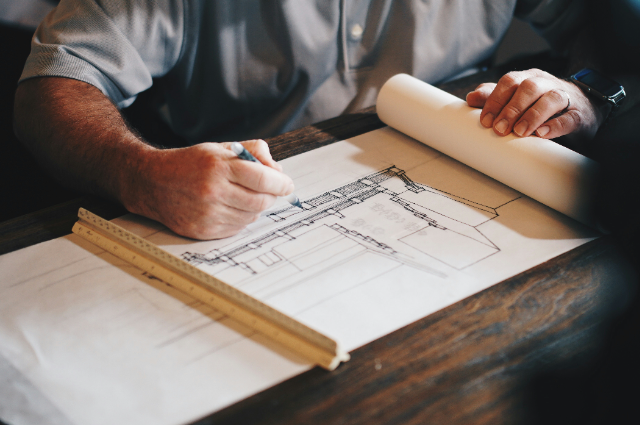
Photo by Daniel McCullough on Unsplash
The Evolution of Architecture Historical Context
Architecture has always reflected the cultural and environmental contexts of its time. From the monumental ziggurats of Mesopotamia to the majestic pyramids of Egypt and the symmetrical temples of ancient India and Greece, early architecture emphasised grandeur, permanence, and function. Yet, as societies evolved, so did architectural philosophies. The transition from purely functional or monumental designs to those incorporating ecological and aesthetic considerations marks a significant shift in architectural history.
Emergence of Net Zero Energy Buildings:
A new architectural paradigm has emerged in recent decades, Net Zero Energy Buildings (NZEBs). These buildings aim to balance energy consumption with renewable energy production on-site, representing a step towards sustainability and efficiency. This approach is part of a broader movement towards living architecture—designs that coexist with and actively enhance their environments.
Lessons from the Past
Ancient Sustainable Practices:
- Vernacular Architecture: Local Materials and Climate Adaptation. Ancient civilizations often used locally available materials and techniques to adapt their structures to the climate. Examples include adobe homes in deserts, stilt houses in flood-prone areas, and stone dwellings in mountainous regions.
- Sustainable Techniques in Hindu and South Indian Architecture, Temple Architecture: Hindu and South Indian temples, such as the Brihadeeswarar Temple in Tamil Nadu, exemplify advanced climate-adaptive designs. These temples were constructed using massive stone blocks that naturally cooled the interior. Water bodies within temple complexes served both spiritual and practical purposes, aiding in cooling and creating a serene environment.
- Vastu Shastra Principles: Vastu Shastra, an ancient Indian architectural doctrine, guided the spatial arrangement of buildings to harmonize with natural forces. Structures like the Padmanabhapuram Palace illustrate how these principles promoted natural ventilation and climate adaptability.
- South Indian Dravidian Architecture: South Indian Dravidian architecture integrated extensive courtyards and large tanks for water storage, blending practicality with aesthetic beauty. The Meenakshi Temple in Madurai, with its gardens and water tanks, highlights the seamless integration of natural elements in architectural design.
The Rise of Living Architecture:
- Defining the Concept - What is Living Architecture?: Living architecture refers to buildings that interact dynamically with their environment, incorporating elements such as green roofs, living walls, and smart materials. These designs aim to enhance the well-being of occupants and contribute positively to the surrounding ecosystem.
- Net Zero Energy Buildings (NZEBs): NZEBs are at the forefront of living architecture. They generate as much energy as they consume, primarily through renewable energy sources like solar panels and wind turbines. This balance is achieved through energy-efficient design, advanced insulation, and innovative technologies.
Green Roofs and Living Walls
- Integrating Nature into Urban Spaces-Green Roofs: Green roofs are vegetative layers grown on rooftops. They provide insulation, reduce stormwater runoff, and create habitats for wildlife.
- Living Walls: Living walls, or vertical gardens, are panels of plants grown on walls. They offer air purification, thermal regulation, and aesthetic benefits.
- Net Zero Synergies: Green roofs and living walls can be integrated with NZEB technologies, such as solar panels, to enhance energy efficiency and environmental benefits.
Smart Materials and Adaptive Designs
- Buildings That Respond Responsive Facades: Responsive facades are made from materials that adjust their properties based on environmental conditions, such as sunlight and temperature.
- Self-Healing Materials: Self-healing materials, like bio-concrete, can repair their cracks using embedded bacteria that produce limestone when exposed to water and air.
- NZEB Technologies: NZEBs utilize smart materials to enhance energy efficiency. Examples include phase-change materials and energy-harvesting windows.
Urban Ecosystems
- Creating Symbiotic Relationships-Buildings as Habitats: Modern buildings can support urban wildlife by integrating habitats such as birdhouses, bat boxes, and insect hotels.
- Ecosystem Services: Buildings can contribute to local ecosystems by incorporating features like rain gardens and integrated wetlands.
- NZEB Contribution: NZEBs contribute to urban ecosystems by reducing carbon footprints and enhancing biodiversity through sustainable design practices.
The Future of Living Architecture
- Innovations on the Horizon-Vertical Forests and Sky Gardens: Vertical forests and sky gardens expand greenery vertically, enhancing urban landscapes and optimizing space.
- Bio-Integrated Buildings: Bio-integrated buildings incorporate living systems, such as algae bioreactors, for energy production and ecological balance.
- Advancements in NZEBs: Emerging technologies are making NZEBs more feasible and efficient, including advancements in renewable energy sources and smart grid integration.
Challenges and Opportunities
Navigating the New Terrain Technological and Economic Barriers - Despite their benefits, living architecture and NZEBs face challenges such as high initial costs and maintenance complexities. Collaboration across disciplines and innovative financing models are essential to overcome these barriers.
Solutions and Innovations:
- Advances in materials science.
- Supportive public policies.
- Increased awareness of sustainability.
Building a Sustainable Future:
Living architecture represents a transformative approach to building design, integrating ecological principles with technological innovation. From ancient practices to modern innovations like NZEBs, buildings are evolving to not only meet human needs but also harmonize with and contribute positively to the natural environment. As we continue to advance in sustainable architecture, the future holds promising developments that will further enhance our urban landscapes while preserving the planet for future generations.
